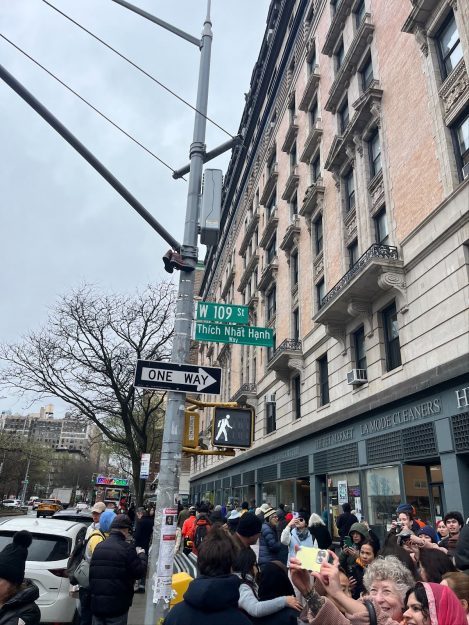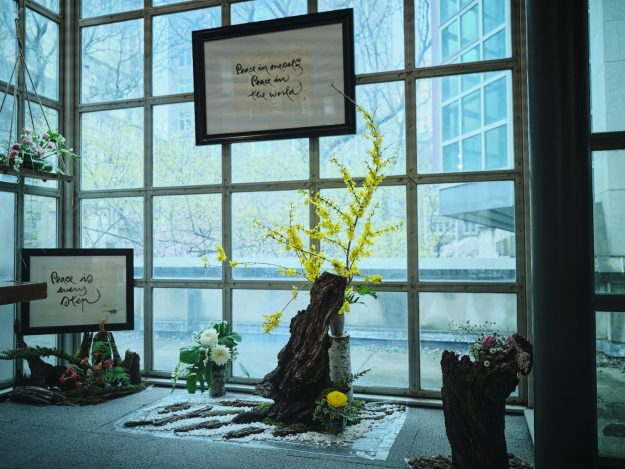Two and a half years ago, Leora Amira and Christina Rosati began collecting signatures from Upper West Side residents with the goal of naming a street after Zen master Thich Nhat Hanh.
At the time of Nhat Hanh’s death, in 2022, Rosati was doing peace work for the conflict in South Sudan. As a reader of his books, Rosati, not a Buddhist herself, was deeply moved by his death and reached out to Buddhist community members across the United States. Kosen Greg Snyder, the senior director of Buddhist Studies at Union Theological Seminary, put her in contact with Amira, a member of the Order of Interbeing.
“I called her right away, it was 2 a.m. in Sudan. We talked like sisters who were separated at birth,” Amira said.
Having both read Fragrant Palm Leaves, Nhat Hanh’s journals from the 1960s, the two hoped to install a sign in his memory on the street of his former residence in New York City.
Their goal was achieved on the cold and rainy morning of April 11, 2025, as the city unveiled Thich Nhat Hanh Way, at the corner of West 109th Street and Broadway.

Nhat Hanh lived on that block, at 306 West 109th Street, from 1962–1963 while a graduate student and lecturer at Columbia University and Union Theological Seminary. Prior to that he studied comparative religion at Princeton Theological Seminary as a Fulbright Scholar from Vietnam.
Monastics from Blue Cliff Monastery in Upstate New York and Deer Park Monastery in California traveled to the city to attend the street’s conaming ceremony, joined by more than 200 other sangha and community members. City councilman Shaun Abreu spoke as a representative of Manhattan’s 7th District.
“This street renaming has power,” Abreu said. “Because here on these streets we’re pulled in a hundred different directions. And yet, by putting his name right here in the heart of it all, we’re creating a moment of pause, a breath, a reminder that peace isn’t found in retreating from the world. It’s found in how we choose to walk through it.”
The date of the street’s naming also has significance, as April 2025 marks the fiftieth anniversary of the end of the Vietnam War. Nhat Hanh’s nonviolent opposition to the civil war and refusal to support either side resulted in his exile from the country in 1966.
Sister The Nghiem of Blue Cliff Monastery, also known as True Vow, is a second-generation Vietnamese-American who was raised culturally Buddhist. However, she didn’t start practicing until her mid-20s, when she joined the Plum Village tradition. Nghiem credits Nhat Hanh’s teachings as being what ultimately touched her heart. She also believes that the work he did during the war is applicable to this day.
“Thay was very concrete about the practice of peace, and he gave us a very clear direction in working for peace,” she said. “He always emphasized that it is the practice of peace, not the destination, so that’s very relevant today, where there are many different things going on, many different conflicts, different wars. But, at the same time, we can still touch peace inside of ourselves and also work in that direction at the same time.”
Amira first learned of Nhat Hanh around twenty years ago at a protest in Israel regarding the wars in Gaza and Lebanon. Through the busyness and noise of the march, she spotted a group of his followers walking slowly and quietly, smiling. Inspired by their embodiment of peace and joy, she began attending their meetings and joined their sangha.
“I said, ‘Well, this is it. I found the real thing.’ ”
In leading the street-naming project, Amira and Rosati collected letters of support and presented their application to the transportation committee of Manhattan’s Community Board 7. It then made its way through the New York City Council. Despite the lengthy process, the city accepted it “so gracefully.”
When CB7 unanimously voted in favor of naming the street, board member Mark Diller said, “Often we name a street to elevate a person, and at times we name a street so that the person elevates us.”
After the street sign was unveiled, the Blue Cliff and Deer Park monastics led a group walking meditation to nearby Union Theological Seminary’s Burke Library, where an exhibit of Nhat Hanh’s calligraphy and books was being displayed. Covering the walls were framed pieces that read phrases such as “enjoy this wonderful moment,” “peace is every breath,” and “peace is every step.”

The reception continued in James Chapel, as monks and nuns gathered onstage to lead an eating meditation for lunch and a chanting session for the bodhisattva Avalokiteshvara, accompanied by guitar, violin, and hand drum. Faculty from Union also gave remarks about Nhat Hanh’s time at the college and the importance of socially engaged Buddhism.
Snyder, who coordinates Union’s Thich Nhat Hanh Program for Engaged Buddhism, said, “When we were standing in the rain this morning, I thought, how many times did he use the rain to describe interconnectedness to us? And there it was, we were in the rain. Of course we should have been, and we were learning.”
Brother Phap Luu of Deer Park Monastery began practicing Nhat Hanh’s teachings of mindfulness in his late 20s, which helped him to retouch the wonders of life, something he said he had lost since being a child. Luu now does work with the Wake Up network, a global community of young adult mindfulness practitioners in the Plum Village tradition. Reflecting on his time with his teacher, Luu noted that Nhat Hanh would have felt humbled and joyful by everyone coming together for the day’s events.
“We find Thay in our step and our mindful breathing and every moment, so he is happy. It’s not that he would be happy, he is happy.”